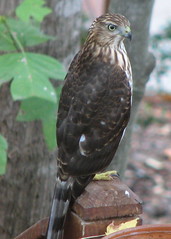 Image by Vicki's Nature via FlickrIn the fall it's very possible you'll see some hawks up close and personal as they shift to their wintering grounds. In mid-Michigan the Cooper's Hawk is one of the most common hawks.
Image by Vicki's Nature via FlickrIn the fall it's very possible you'll see some hawks up close and personal as they shift to their wintering grounds. In mid-Michigan the Cooper's Hawk is one of the most common hawks. So yesterday, when a bright yellow-eyed young hawk walked across the back deck and peeked in the screen door, avid bird feeder that I am, I thought, "what can I feed her?" I'm vegetarian and her normal diet probably consists of small rodents and slow birds like Mourning Doves, not something I keep in the fridge. Perhaps I could entice her with my tofu. I'll never know. A little skittish from my excited movement in the house, she moved over to a nearby tree.
I had just filled the feeders and a chickadee was chipping cheerily oblivious to any danger. (Don't worry there is no bloody ending.) My mom told me chickadees give hawks the hiccups and maybe this hawk's mother told her the same thing because she didn't even glance at the bird. Or maybe she just had a craving for a saucy chipmunk. Whatever was on the bird's mind, she soon left.
I could tell she was very young. The juveniles migrate first. They have yellow eyes, brown backs and a white belly with reddish-brown streaks. As they mature the Cooper's Hawks' eyes darken, first to orange, and then to red in older adults. The adults back feathers are also a darker blue-gray and their belly is white with rufous barring.
If you feed birds long enough, a Hawk will likely show up sooner or later. Sometimes the hawk perches for a while. It is on those occasions that the phone at Wild Birds Unlimited starts ringing: "How can I get rid of this thing? It's killing my birds!" Of course that is what certain kinds of hawks do.
The most common neighborhood hawks in mid-Michigan are the sharp-shinned and Cooper's hawks. They are usually woodland hunters, and with their habitat shrinking more sitings have been reported at well-stocked feeding stations. Hawks have to eat too, and whether they are hunting around your feeder or off in the woods, they are going to catch about the same amount of prey each day. Consider yourself lucky that you have a front row seat to one of nature's more dramatic dances.
Some steps to take if you have hawks in your yard:
- First and foremost, federal and state laws prohibit the capture, killing, or possession of hawks and owls. Raptors at bird feeding stations are a problem only when they perch nearby all day. The birds return as soon as the Hawk flys away. So rather than get upset, enjoy a close-up look at these magnificent birds while they are in your yard.
- Place your feeders where there is ample natural protection. Evergreen shrubs and trees can provide an easy escape for the birds. If there is none available, consider planting a few varieties.
- Acknowledge that a few birds and squirrels will be caught by Hawks at your feeders. This is part of the cycle. Raptors play an important role in controlling the populations. Also keep in mind; songbirds are difficult for hawks to catch. Few are caught by birds of prey.
- Ultimately, the only thing you can do when a hawk comes to dinner is wait it out. Most hawks that settle in at feeders do so for two or three weeks and then they are off again to different territory. The presence of hawks at your feeders should in no way cause you to discontinue feeding birds. Just take a few simple steps to protect them and enjoy a season of bird feeding.
Category ›
Bird of the week
 Unknown
Unknown
 Saturday, September 4, 2010
Saturday, September 4, 2010









No comments:
Post a Comment